
The order Pinales in the division Pinophyta, class Pinopsida, comprises all the extant conifers. The distinguishing characteristic is the reproductive structure known as a cone produced by all Pinales. All of the extant conifers, such as Araucaria, cedar, celery-pine, cypress, fir, juniper, kauri, larch, pine, redwood, spruce, and yew, are included here. Some fossil conifers, however, belong to other distinct orders within the division Pinophyta.
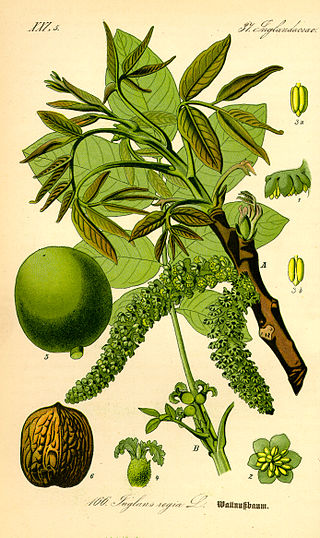
Juglandales is an order of flowering plants. This order was recognised in several systems. The Cronquist system placed the order in the subclass Hamamelidae, as comprising the families Juglandaceae and Rhoipteleaceae, the latter consisting of only a single species.

Violaceae is a family of flowering plants established in 1802, consisting of about 1000 species in about 25 genera. It takes its name from the genus Viola, the violets and pansies.

Ochnaceae is a family of flowering plants in the order Malpighiales. In the APG III system of classification of flowering plants, Ochnaceae is defined broadly, to include about 550 species, and encompasses what some taxonomists have treated as the separate families Medusagynaceae and Quiinaceae. In a phylogenetic study that was published in 2014, Ochnaceae was recognized in the broad sense, but two works published after APG III have accepted the small families Medusagynaceae and Quiinaceae. These have not been accepted by APG IV (2016).
Spondianthus is a genus of plant, in the family Phyllanthaceae and is the only genus comprised in the tribe Spondiantheae. It was first described as a genus in 1905. The genus contains only one recognized species, Spondianthus preussii, widespread across much of tropical Africa from Liberia to Mozambique.
- Spondianthus preussii subsp. glaber(Engl.) J.Léonard & Nkounkou – from Nigeria to Tanzania south to Angola; also Guinea, Ivory Coast
- Spondianthus preussii subsp. preussii – from Liberia to Zaire

Arthur John Cronquist was an American biologist, botanist and a specialist on Compositae. He is considered one of the most influential botanists of the 20th century, largely due to his formulation of the Cronquist system as well as being the primary co-author to the Flora of the Pacific Northwest, still the most up to date flora for three northwest U.S. States to date. Two plant genera in the aster family have been named in his honor. These are Cronquistia, a possible synonym of Carphochaete, and Cronquistianthus, which is sometimes included as a group within Eupatorium. The former was applied by R.M. King and the latter by him and Harold E. Robinson.

Heinrich Gustav Adolf Engler was a German botanist. He is notable for his work on plant taxonomy and phytogeography, such as Die natürlichen Pflanzenfamilien, edited with Karl A. E. von Prantl.

Myrothamnus is a genus of flowering plants, consisting of two species of small xerophytic shrubs, in the southern parts of tropical Africa and in Madagascar. Myrothamnus is recognized as the only genus in the family Myrothamnaceae.
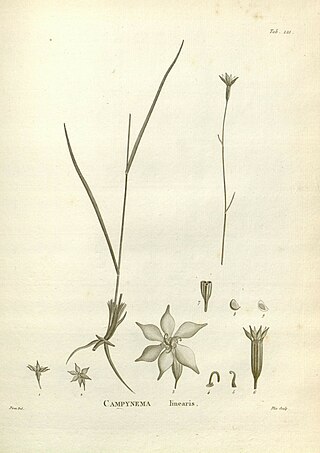
Campynemataceae (Campynemaceae) is a family of flowering plants. The family consists of two genera and four species of perennial herbaceous plants endemic to New Caledonia and Tasmania.

Lilianae is a botanical name for a superorder of flowering plants. Such a superorder of necessity includes the type family Liliaceae. Terminations at the rank of superorder are not standardized by the International Code of Nomenclature for algae, fungi, and plants (ICN), although the suffix -anae has been proposed.
Isolona zenkeri is a species of plant in the Annonaceae family. It is found in Cameroon, The Republic of the Congo and Gabon. Adolf Engler, the German botanist who first formally described the species, named it after Georg August Zenker who collected the sample Engler examined. Its natural habitat is subtropical or tropical moist lowland forests. It is threatened by habitat loss.

Lepidobotryaceae is a family of plants in the order Celastrales. It contains only two species: Lepidobotrys staudtii and Ruptiliocarpon caracolito.

Ruptiliocarpon is a monotypic genus of flowering plants in the family Lepidobotryaceae. The genus has only one species, Ruptiliocarpon caracolito. It is a tall tree that grows in several small isolated areas of Central and South America. It is known from Costa Rica, Colombia, Peru, and Suriname. It is locally common on hillsides and other well-drained areas, often in red clay, from near sea level to 400 m in elevation.
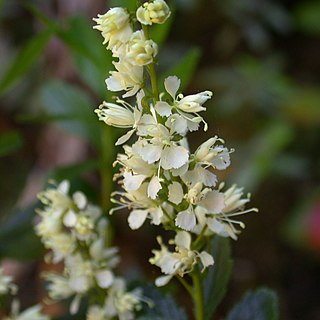
Tetracarpaea is the only genus in the flowering plant family Tetracarpaeaceae. Some taxonomists place it in the family Haloragaceae sensu lato, expanding that family from its traditional circumscription to include Penthorum and Tetracarpaea, and sometimes Aphanopetalum as well.

3,4,5-Tri-O-galloylquinic acid is a hydrolysable tannin found in Lepidobotrys staudtii, in Guiera senegalensis or in the resurrection plant.

Guiera is a flowering plant genus in the family Combretaceae. Guiera senegalensis is the only known species in the genus, found in Tropical Africa in dry areas from Senegal to Sudan. The plant produces the tannin 3,4,5-Tri-O-galloylquinic acid and several alkaloids of the harmane family.
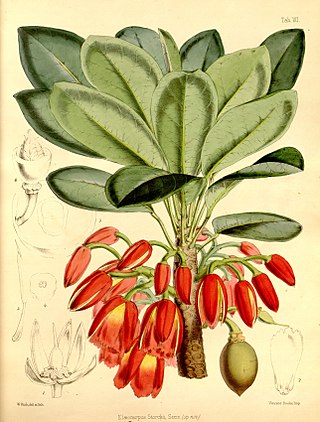
Reinhard Gustav Paul Knuth (1874–1957) was a German taxonomist, botanist and pteridologist responsible for "Initia florae venezuelensis" in 1928, and numerous contributions to Adolf Engler's "Das Pflanzenreich" on Geraniaceae, Oxalidaceae, Lecythidaceae, and other families.
Hubert Winkler was a German botanist, who specialized in tropical flora research.
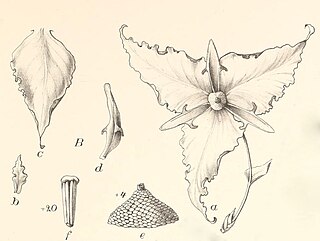
Monodora minor is a species of plant in the family Annonaceae. It is native to Mozambique and Tanzania. Heinrich Gustav Adolf Engler and Ludwig Diels, the German botanists who first formally described the species, do not explicitly explain the specific epithet but it is among the smaller members of the genus which includes species that reach heights of 30-40 meters.

















